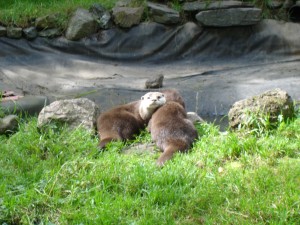Giant Otter Fact file
 The otter is a member of the Mustelidae family, or the weasel family as it is more commonly known. This family consists of animals such as polecats, badgers, martens, tayras, stoats, otters and weasels.
The otter is a member of the Mustelidae family, or the weasel family as it is more commonly known. This family consists of animals such as polecats, badgers, martens, tayras, stoats, otters and weasels.
Today we have a guest author, Tony Mandarich, who has put together a fact file of the Giant Otter.
Rainforest Animals – Giant Otter
By Tony Mandarich
Name:
Giant Otter
Scientific Name:
Pteronura brasiliensis
Status:
Endangered
Scientific Classification:
Kingdom: Animalia
Phylum: Chordata
Class: Mammalia
Order: Carnivora
Family: Mustelidae
Genus: Pteronura
Species: P. brasiliensis
General Information:
The giant otter is an amphibious carnivore and one of the largest members of the mustelidae family. Although it is the longest in the weasel family, the sea otter is heavier. In its native Amazonian habitats, the giant otter is an apex predator and is active exclusively in daylight hours (diurnal). Although once abundant in South America, its numbers have been greatly reduced, with current estimates generally listing its wild population at lower than 5,000. The giant otter has been hunted for its pelt, and its habitat has been greatly degraded. It is listed as an “Endangered Species”.
Physical Description:
The male otter can measure anywhere between 4.9 and 5.9 feet in length, and the female is generally a bit smaller at 4.9 – 5.6 feet long. Some exceptionally massive specimens once occurred at, reportedly, nearly 8 feet, but hunting has probably reduced the existence of such large specimens. Male otters weigh in around 57 – 70 lbs, and females at around 48 – 57 lbs. Its fur is short and dense, and is brownish in color. It is also velvety in texture, which has made the giant otter a prized victim of pelt poachers. There are also light-colored markings on its throat, which are unique and allow identification of specific individuals from birth.
Diet:
Giant otters feeds on fish, and supplement their diet with crustaceans, small snakes, and even caimans. An adult can eat up to 10 lbs of fish per day. They hunt alone and in groups.
Habitat:
Giant otters occur in freshwater habitats that are often located in forested regions. They prefer rivers, lakes, and flooded areas where the water currents are gentle. It is primarily terrestrial, but is amphibious in nature. It has lost as much as 80% of its original South American Amazon range, but still currently habits areas of Bolivia, Brazil, Colombia, Ecuador, French Guiana, Guyana, Paraguay, Peru, Suriname, and Venezuela.
Reproduction:
The gestation period lasts about 65 – 70 days, after which time 1 – 5 (with an average of 2) pups are born. The giant otter reaches sexual maturity at around 2 years of age. Males actively participate in rearing the young, as do older, juvenile siblings.
In addition to writing online articles, Tony also has interests in projector lamp center and infocus projector lamps.
Article Source: http://EzineArticles.com/?expert=Tony_Mandarich
http://EzineArticles.com/?Rainforest-Animals—Giant-Otter&id=1073012
 Otters are amazing creatures and are becoming slightly more common in some parts of the British countryside; a couple of years ago I saw one in Dartmoor, Devon running along the riverbank.
Otters are amazing creatures and are becoming slightly more common in some parts of the British countryside; a couple of years ago I saw one in Dartmoor, Devon running along the riverbank.
 October 29, 2010
В·
October 29, 2010
В·  Maddia (Admin) В·
Maddia (Admin) В·  Comments Closed
Comments Closed
 Posted in: Otters
Posted in: Otters


